Multiple Choice
Identify the
choice that best completes the statement or answers the question.
|
|
|
1.
|
Points from a rational function are shown in the table
below.
x | f(x) | -4 | 1.8333 | -3 | 1.75 | -2 | 1.5 | -1 | Undefined | 0 | 2.5 | 1 | 2.25 | 2 | 2.1667 | | |
Based on the information
in the table, which of the following statements is NOT true about the function?
A. | The x-intercept is (-1, 0) | B. | The vertical asymptote is x = -1. | C. | The y-intercept if (0, 2.5). | D. | The horizontal asymptote is y = 2. |
|
|
|
2.
|
Which of the following represents
f-1(x), the inverse of the function f(x) =
–3(4x – 1)2 +3?
A. | f-1(x) = 
| B. | f-1(x) = 
| C. | f-1(x) =  | D. | f-1(x) = 
|
|
|
|
3.
|
Which of the following is not an exponential growth
function?
A. | h(x) =
(1.25)x | B. | h(x) = (1
– 0.2)x + 3 | C. | g(x) =  – 12 – 12 | D. | g(x) = (1 +
0.3)x – 7 |
|
|
|
4.
|
The graph of f(x) is shown below.

Which of the following is a graph of the inverse of
f(x)?
|
|
|
5.
|
These two functions are represented on the graph:
g(x) = 23x – 1 and h(x) =  .
Which of the attributes is the same for both functions? .
Which of the attributes is the same for both functions?
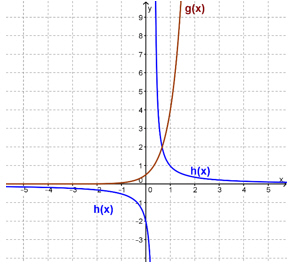
A. | Range | B. | Domain | C. | Horizontal
asymptote | D. | Vertical asymptote |
|
|
|
6.
|
Look at the graph below.
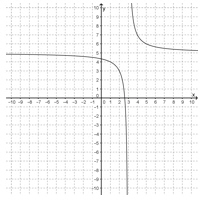
Which of the following represents the vertical and horizontal
asymptotes?
A. | x = 3
y = 5 | B. | x = 5
y = 0 | C. | x = 5
y =
3 | D. | x = 0
y =
5 |
|
|
|
7.
|
Points from the exponential function g(x)
=  are shown in the table below. Which of the
following statements is NOT true about the function? are shown in the table below. Which of the
following statements is NOT true about the function?
A. | The function is a vertical stretch from the function
f(x) =  | B. | The horizontal asymptote of the function is y = 16. | C. | The function is exponential decay. | D. | The y-intercept of the function is (0,
16). |
|
|
|
8.
|
Identify the function that was transformed from the
exponential function f(x) = (2)x by reflecting it over the
x-axis and translating it down 5 units.
A. | g(x) = (2)–x –
5 | B. | g(x) = –(2)x –
5 | C. | g(x) = (2)–x –
5 | D. | g(x) = –(2)x –
5 |
|
|
|
9.
|
Which of the following represents
f-1(x), the inverse of the function f(x) =  x + 8? x + 8?
A. | f-1(x) = 2(x
– 8) | B. | f-1(x) =  | C. | f-1(x) =  | D. | f-1(x) = 2(x +
8) |
|
|
|
10.
|
The function f(x) =  is
transformed by the function f(x) = is
transformed by the function f(x) =  . Which of the following
describes the transformations? . Which of the following
describes the transformations?
A. | vertical stretch by a factor of 3
horizontal shift right 5
units
vertical shift down 1 unit | B. | vertical stretch by a
factor of 3
horizontal shift left 5 units
vertical shift up 1 unit | C. | vertical stretch by a factor of 3
horizontal shift left 5 units
vertical shift
down 1 unit | D. | vertical compression by a
factor of 3
horizontal shift left 5 units
vertical shift down 1
unit |
|
|
|
11.
|
The table below contains values of the function
f(x).
Which of the following tables represents the
inverse of f(x)?
|
|
|
12.
|
The function g(x) =
–(0.5)x + 4 is represented in the graph below.

Which of the following best describes the
domain and range of the given function?
A. | The domain is –¥ < x < ¥, and the range is –¥ < g(x) < ¥. | B. | The domain is –¥ <
x < ¥, and the range is
–¥ < g(x)
£ 3. | C. | The domain is –4 < x < 8, and the range is –12 <
g(x) £
8. | D. | The domain is –¥ < x < ¥, and the range is –¥ < g(x) <
4. |
|
|
|
13.
|
The graph of f(x) is shown below.

The list below shows possible domain restrictions for
f(x).
I. x > 3
II. x < 3
III. x >
0
IV. x < 0
How should the domain be
restricted to ensure the inverse of f(x) is a function?
A. | I and II only | B. | III and IV only | C. | III
only | D. | IV only |
|
|
|
14.
|
Look at the graph
below.
Which of the graphs below represents the graph of the inverse of the
function?
|
|
|
15.
|
Which of the following statements is true about the function
and the inverse of the function graphed below?
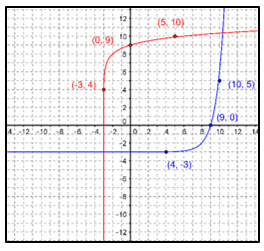
A. | f(x): x-intercept (9, 0); y-intercept
(-3, 0)
f-1(x): x-intercept (0, 9);
y-intercept 0, -3) | B. | f(x):
x-intercept (9, 0); y-intercept (0, -3)
f-1(x): x-intercept (-3, 0); y-intercept (0,
9) | C. | f(x): x-intercept (0, 9); y-intercept
(9, 0)
f-1(x): x-intercept (-3, 0);
y-intercept (-3, 0) | D. | f(x):
x-intercept (9, 0); y-intercept (0, 9)
f-1(x): x-intercept (-3, 0); y-intercept 0,
-3) |
|
|
|
16.
|
Look at the function below.
Which of the following represents the domain and range of the
function?
A. | {x | x Îÿ, x
¹ 5}
{y | y Îÿ, y
¹ 0} | B. | {x | x
Îÿ,
x ¹ 0}
{y | y Îÿ, y
¹ -5} | C. | {x | x Îÿ, x ¹ 0}
{y | y Îÿ, y ¹ 5} | D. | {x | x Îÿ, x ¹ -5}
{y | y Îÿ, y
¹ 0} |
|
|
|
17.
|
The graph of f(x) is shown below.

Which of the following points would be contained in the inverse of
f(x)?
A. | (-6, -3) | B. | (-3,
-6) | C. | (-3, 6) | D. | (6,
3) |
|
|
|
18.
|
Look at the table below.
Which of the following tables represents the
inverse of the function?
|
|
|
19.
|
Look at the graph below.
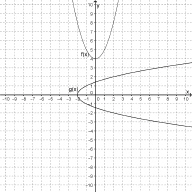
Which of the following statements is true about the function shown on the
graph?
A. | g(x) is the inverse of
f(x). | B. | f(x)
reflected across the line of reflection, y = x, is
g(x). | C. | g(x) is a
function. | D. | The domain of f(x) and the range of
g(x) do not contain the same values. |
|
|
|
20.
|
Look at the graphs below.
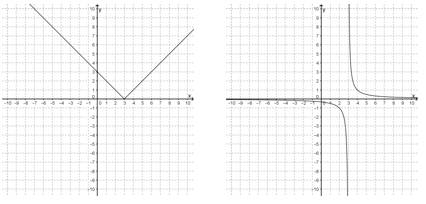
Which of the following attributes is the same for both
functions?
A. | Domain | B. | Range | C. | x-intercept | D. | None of these are the
same. |
|